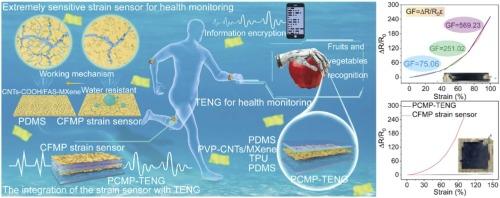Multifunctional electronic skin with waterproof strain sensing and ultra-stretchable triboelectric energy harvesting
IF 17.1
1区 材料科学
Q1 CHEMISTRY, PHYSICAL
引用次数: 0
Abstract
Wearable flexible strain sensors and single-electrode triboelectric nanogenerators (TENGs) have emerged as promising building blocks for smart electronic skin applications. However, only a few studies have succeeded in integrating both technologies into a single device while maintaining stable and reliable performance. Here, we present a simple and scalable fabrication approach using spraying, electrostatic spinning, and vacuum filtration to develop a multifunctional system comprising a water-resistant strain sensor and a stretch-insensitive TENG. The strain sensor is constructed from carboxylated carbon nanotubes (CNTs-COOH), fluorinated alkyl silane-modified Ti3C2Tx (FAS-MXene), and a flexible polydimethylsiloxane (PDMS). The TENG consists of a film made of polyvinylpyrrolidone-modified CNTs (PVP-CNTs), Ti3C2Tx (MXene), and electrospun thermoplastic polyurethane nanofibres (TPU) as an electrode. When employed as a strain sensor, the device demonstrates high sensitivity, a wide sensing range (0% to 100% strain), excellent water resistance, and outstanding durability (5,000 cycles at 50% strain). These properties are achieved through MXene surface chemical modification and a unique microcrack structure developed under strain. As a highly stretchable TENG, the device exhibits remarkable stability, with minimal changes in relative resistance (0.03 at 20% strain) even after 5,700 cycles, owing to the strong adhesion forces generated by hydrogen bonding interactions between the porous TPU film, PVP-CNTs, and MXene. The integrated device enables simultaneous strain sensing and self-powering capabilities, offering a versatile platform for applications such as health monitoring, encrypted information transmission, and object recognition. The low cost and ease of mass fabrication of this electronic skin mark a significant advancement towards future multifunctional wearable technologies.

具有防水应变传感和超拉伸摩擦电能量收集功能的多功能电子皮肤
可穿戴柔性应变传感器和单电极摩擦电纳米发电机(TENGs)已经成为智能电子皮肤应用的有前途的基石。然而,只有少数研究成功地将这两种技术集成到一个设备中,同时保持稳定可靠的性能。在这里,我们提出了一种简单且可扩展的制造方法,使用喷涂,静电纺丝和真空过滤来开发一个多功能系统,该系统包括一个防水应变传感器和一个拉伸不敏感的TENG。该应变传感器由羧基化碳纳米管(CNTs-COOH)、氟化烷基硅烷改性Ti3C2Tx (FAS-MXene)和柔性聚二甲基硅氧烷(PDMS)组成。TENG由聚乙烯吡啶烷酮改性碳纳米管(PVP-CNTs)、Ti3C2Tx (MXene)和电纺丝热塑性聚氨酯纳米纤维(TPU)制成的薄膜作为电极组成。当用作应变传感器时,该设备具有高灵敏度,宽传感范围(0%至100%应变),优异的耐水性和出色的耐久性(50%应变下5000次循环)。这些性能是通过MXene表面化学改性和应变下形成的独特微裂纹结构实现的。作为一种高度可拉伸的TENG,由于多孔TPU膜、PVP-CNTs和MXene之间的氢键相互作用产生的强大附着力,即使在5700次循环后,该装置也表现出显著的稳定性,相对电阻的变化很小(20%应变时为0.03)。该集成设备可同时实现应变传感和自供电功能,为健康监测、加密信息传输和目标识别等应用提供多功能平台。这种电子皮肤的低成本和易于大规模制造标志着未来多功能可穿戴技术的重大进步。
本文章由计算机程序翻译,如有差异,请以英文原文为准。
求助全文
约1分钟内获得全文
求助全文
来源期刊

Nano Energy
CHEMISTRY, PHYSICAL-NANOSCIENCE & NANOTECHNOLOGY
CiteScore
30.30
自引率
7.40%
发文量
1207
审稿时长
23 days
期刊介绍:
Nano Energy is a multidisciplinary, rapid-publication forum of original peer-reviewed contributions on the science and engineering of nanomaterials and nanodevices used in all forms of energy harvesting, conversion, storage, utilization and policy. Through its mixture of articles, reviews, communications, research news, and information on key developments, Nano Energy provides a comprehensive coverage of this exciting and dynamic field which joins nanoscience and nanotechnology with energy science. The journal is relevant to all those who are interested in nanomaterials solutions to the energy problem.
Nano Energy publishes original experimental and theoretical research on all aspects of energy-related research which utilizes nanomaterials and nanotechnology. Manuscripts of four types are considered: review articles which inform readers of the latest research and advances in energy science; rapid communications which feature exciting research breakthroughs in the field; full-length articles which report comprehensive research developments; and news and opinions which comment on topical issues or express views on the developments in related fields.
 求助内容:
求助内容: 应助结果提醒方式:
应助结果提醒方式:


